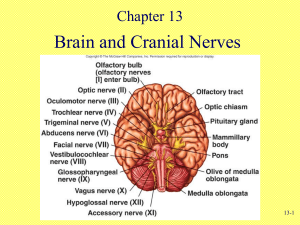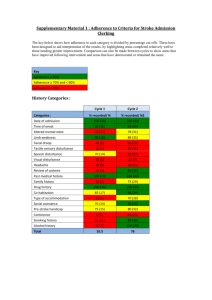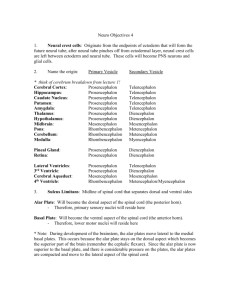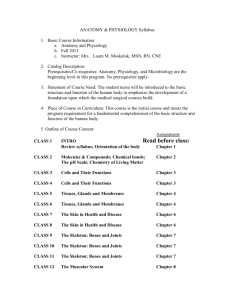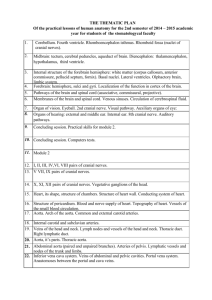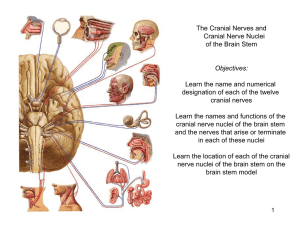Central nervous system Development of the brain
advertisement
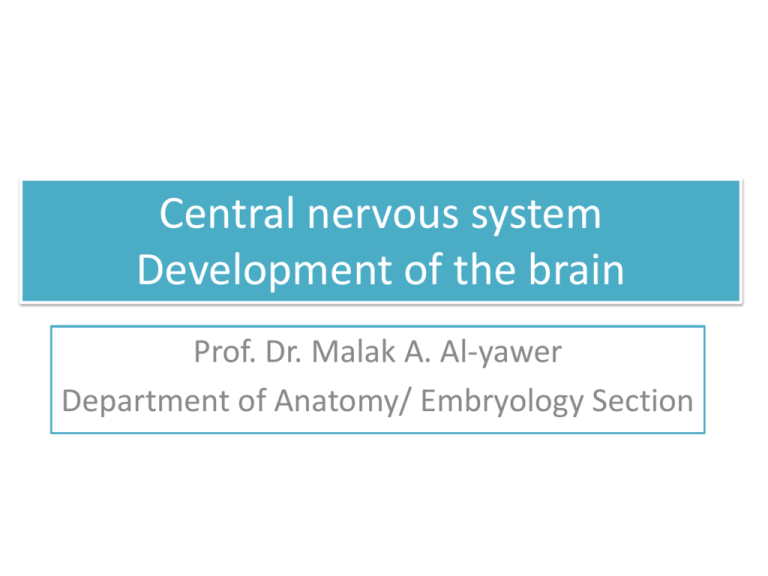
Central nervous system Development of the brain Prof. Dr. Malak A. Al-yawer Department of Anatomy/ Embryology Section Learning objectives At the end of this lecture, the medical student will be able to Define the primary brain vesicles and state their fates Name the flexures that present in the cephalic end of neural tube State the role of basal and alar plates in the formation of different parts of the brain Describe the embryonic origin of olfactory system State the embryonic origin of different types of commissures Define the embryonic origin of cranial nerves and state the embryonic origin of their motor nuclei, sensory ganglion and parasympathetic ganglion State some clinical correlates Primary brain vesicles Three dilations( primary brain vesicles): (a) Prosencephalon (forebrain) (b) Mesencephalon (midbrain) (c) Rhombencephalon (hindbrain) Two flexures: A. Cervical flexure spinal cord (b) Cephalic flexure hindbrain - midbrain Rhombencephalic isthmus mesencephalon -rhombencephalon Rhombencephalon (Hindbrain) consists of the (a) Metencephalon pontine flexure -rhombencephalic isthmus later forms the pons and cerebellum (b) Myelencephalon most caudal of the brain vesicles forms the medulla oblongata Pontine flexure Myelencephalon differs from the spinal cord in that its lateral walls are everted the sulcus limitans can be clearly distinguished. The basal plate contains motor nuclei The alar plate contains three groups of sensory relay nuclei The roof plate Tela choroidea Choroid plexus Metencephalon 1. pons Basal plate / 3 groups of motor neurons Alar plate / 3 groups of sensory nuclei Marginal layer of its basal plates expands & makes a bridge for nerve fibers Pontine nuclei originate in the alar plates of the metencephalon and myelencephalon Metencephalon 2. Cerebellum rhombic lips cerebellar plate shows vermis and 2 hemispheres (12 week embryo) A transverse fissure separates the nodule from the vermis and the lateral flocculus from the hemispheres . Flocculonodular lobe is phylogenetically the most primitive part of the cerebellum. Mesencephalon (Midbrain ) Basal plate / 2 groups of motor nuclei Marginal layer of its basal plate enlarges and forms the crus cerebri Alar plates Initially / 2 longitudinal elevations separated by a shallow midline depression With further development, a transverse groove divides each elevation into superior & inferior colliculi Prosencephalon 1. Diencephalon develops from the median portion of the prosencephalon characterized by outgrowth of the optic vesicles and forms the optic cup and stalk pituitary thalamus hypothalamus epiphysis Roof plate choroid plexus of 3rd ventricle Its most caudal part develops into the pineal body ( epiphysis) Alar plates / lateral walls of the diencephalon. Hypothalamic sulcus Prosencephalon 2. Telencephalon consists of 2 lateral outpocketings ( cerebral hemispheres) a median portion(lamina terminalis) / used by commissures • Insula: the depressed area between the frontal and temporal lobes. At the time of birth it is completely covered. • During the final part of fetal life, the surface of the cerebral hemispheres grows so rapidly that a great many convolutions (gyri) separated by fissures and sulci appear on its surface Olfactory system epithelial– mesenchymal interactions between 1. neural crest cells and ectoderm of the frontonasal prominence olfactory placodes / primary sensory neurons 2. same crest cells and the floor of the telencephalon - olfactory bulbs/ secondary neurons By the 7th week, these contacts are well established. Commissures • Anterior commissure first to appear connecting the olfactory bulb and related brain areas of one hemisphere to those of the opposite side • Hippocampal commissure ( fornix commissure ) second to appear arise in the hippocampus and converge on the lamina terminalis to the mamillary body and the hypothalamus • Corpus callosum appears by the 10th week of development connects the non olfactory areas of the right and the left cerebral cortex • Posterior and habenular commissures / below and rostral to the stalk of the pineal gland. • Optic chiasma rostral wall of the diencephalon contains fibers from the medial halves of the retinae. Cranial Defects Holoprosencephaly (HPE) • Loss of midline tissue has resulted in a midline cleft lip, lack of nasal tissue, and eyes that are too close together • The loss of midline tissue causes the lateral ventricles to merge into a single chamber. Drawings illustrating various types of skull defects meningocele (B) Meningoencephalocele(C) Meningohydroencephalocele(D) usually occur in the occipital region, but may occur in the frontonasal region. Origin of these defects is due to abnormal neural tube closure/ can be prevented by maternal use of folic acid Hydrocephalus • is due to an obstruction of the aqueduct of Sylvius (aqueductal stenosis). • This prevents the CSF of the lateral and third ventricles from passing into the 4th ventricle and from there into the subarachnoid space, where it would be resorbed. • As a result, fluid accumulates in the lateral ventricles and presses on the brain and bones of the skull. Microcephaly • a cranial vault is smaller than normal • due to poor growth of the brain • frequently associated with mental retardation. Cranial nerves • 4th week of development/ nuclei for all 12 cranial nerves are present. • All except the olfactory (I) and optic (II) nerves arise from the brainstem, and of these only the oculomotor (III) arises outside the region of the hindbrain. • The hindbrain is divided into eight rhombomeres (r1–r8) - give rise to motor nuclei of cranial nerves IV, V, VI, VII, IX, X, XI, and XII. • Motor neurons for cranial nuclei are within the brainstem, while sensory ganglia are outside of the brain. Cranial nerve sensory ganglia Parasympathetic (visceral efferent) ganglia 1. 2. • 1. 2. 3. • derived from neural crest cells • their fibers are carried by cranial nerves III, VII, IX, and X originate from ectodermal placodes and neural crest cells Ectodermal placodes include Nasal placode otic placode four Epibranchial placodes dorsal to the pharyngeal (branchial) arches & contribute to ganglia for nerves of the pharyngeal arches (V, VII, IX, and X). Summary The cephalic end of the neural tube shows three dilations (primary brain vesicles) The cephalic end of the neural tube forms two flexures: cervical and cephalic flexures Rhombencephalic isthmus separates the mesencephalon from the rhombencephalon Distinct basal and alar plates, representing motor and sensory areas, respectively, are found on each side of the midline in the rhombencephalon and mesencephalon In the prosencephalon, however, the alar plates are accentuated and the basal plates regress Differentiation of the olfactory system is dependent on epithelial– mesenchymal interactions All cranial nerves except olfactory (I) and optic (II) nerves arise from the brainstem Cranial nerve sensory ganglia originate from ectodermal placodes and neural crest cells Parasympathetic (visceral efferent) ganglia are derived from neural crest cells
